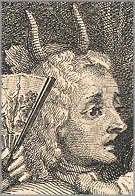 |
||||||||||||||||||||||||||||
 |
||||||||||||||||||||||||||||
|
||||||||||||||||||||||||||||
© Great Caricatures
2023
In Development • In Development • In Development
![]() WILLIAM
HOGARTH
WILLIAM
HOGARTH ![]()
Plates, Pirates, & Publishers

3rd state, c. 1800
Boydell Edition

4th state, 1822
BCJ Heath Edition
These details illustrate three states and three editions of "Evening" from Hogarth's Four Times of Day series. The prints were pulled from Hogarth's original plate over a period of 84 years.
Hogarth's Plates The plates Hogarth engraved for his prints are at the heart of a tale that offers insights into the history of British commerce, the evolution of copyright and the development of printing. From 1720 until his death in 1764 Hogarth worked to bring his art to as wide an audience as possible. He published thousands of prints: individual editions, suites of prints, and bound volumes. These Lifetime Editions were internationally recognized and became the works upon which his reputation is based. Hogarth's first painted his images on canvas and then, working alone or with the assistance of master engravers, carefully transfered them to copper plates. The images were rendered with intricate linework that captured minute details, delicate lighting effects, and subtle characterizations. When published on large sheets of heavy laid paper, the images had a broad range of silver-grey tones. Piracies Hogarth fought hard to be compensated for his work. When he began his career the London print market was dominated by a handful of printsellers who kept artists at an economic disadvantage and often financed pirate editions of popular works. Hogarth set up his own studio but found that before he could publish his prints, his work was pirated by artists who viewed his paintings and engraved unauthorized editions. In the early 1700s England did not have a law that protected the rights of artists. After learning a bitter lesson of piracy, he withheld publication of the Rake's Progress until he and his fellow artists lobbied Parliament to pass a new Copyright Act. Kirkall and others. Other Publishers When Hogarth died he left his wife Jane over 200 engraved plates. She supported herself by publishing new editions. In 1780, Horace Walpole, an author and Member of Parliament, wrote an enthusiastic analysis of Hogarth's work. Five years later John Nichols published the Biographical Anecdotes of William Hogarth. He wrote that Walpole's work was "followed by an immediate rage for collecting every scrap of our Artist's designs". 2 Throughout the 1800s, editions and folios were continuously published by a series of publishers. In 1789 Jane Hogarth sold the plates to John Boydell. He published editions until until 1818 when the plates were bought by Baldwin, Cradock and Joy who sold them to Henry Bohn in 1835. Over time, the plates became worn and some publishers hired artists to "restore" the plates. Often their linework replaced what Hogarth had originally created. In the early 20th century many of Hogarth's plates were sold to the British government. During the first World War they were melted down and used to make bombs. The remaining plates were sold to private collectors. Copies The market for Hogarth's work went beyond the prints published from his plates. Beginning in the late 1700s and throughout the 1800s books were published with illustrations and commentaries on Hogarth's work. |
|||||
Problems of Attribution
|
|||||
Acknowledgements
Vladislav Ruchkin and Fred Tempereau
Notes
1. Horace Walpole, Anecdotes of Painting in England, Volume IV, Chapter XX, 1786; Reprint by Alexander Murray, London, 1871
2. John Nichols, Biographical Anecdotes of William Hogarth, Third Edition,1785, p. iii; Facsimile by Cornmarket Press, London, 1971
Additional Sources
Ronald Paulson, Hogarth's Graphic Works, Third Revised Edition, The Print Room, London, 1989
Richard Vogler, Reading Hogarth, Introduction to Catalogue Exhibition, Grunwald Center for the Graphic Arts, Wight Art Gallery, UCLA, 1988
